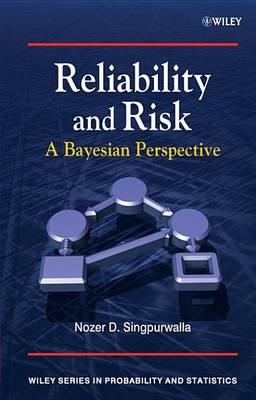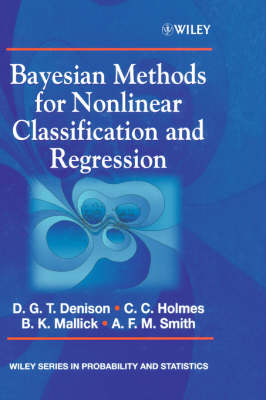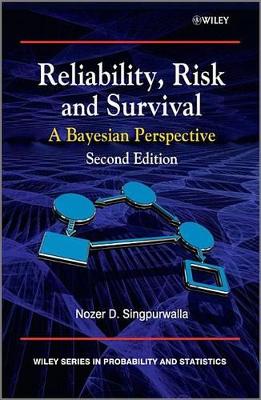Wiley Series in Probability and Statistics
4 total works
We all like to know how reliable and how risky certain situations are, and our increasing reliance on technology has led to the need for more precise assessments than ever before. Such precision has resulted in efforts both to sharpen the notions of risk and reliability, and to quantify them. Quantification is required for normative decision-making, especially decisions pertaining to our safety and wellbeing. Increasingly in recent years Bayesian methods have become key to such quantifications. Reliability and Risk provides a comprehensive overview of the mathematical and statistical aspects of risk and reliability analysis, from a Bayesian perspective. This book sets out to change the way in which we think about reliability and survival analysis by casting them in the broader context of decision-making. This is achieved by: * Providing a broad coverage of the diverse aspects of reliability, including: multivariate failure models, dynamic reliability, event history analysis, non-parametric Bayes, competing risks, co-operative and competing systems, and signature analysis.*
Covering the essentials of Bayesian statistics and exchangeability, enabling readers who are unfamiliar with Bayesian inference to benefit from the book.* Introducing the notion of "composite reliability", or the collective reliability of a population of items.* Discussing the relationship between notions of reliability and survival analysis and econometrics and financial risk. Reliability and Risk can most profitably be used by practitioners and research workers in reliability and survivability as a source of information, reference, and open problems. It can also form the basis of a graduate level course in reliability and risk analysis for students in statistics, biostatistics, engineering (industrial, nuclear, systems), operations research, and other mathematically oriented scientists, wherein the instructor could supplement the material with examples and problems.
Covering the essentials of Bayesian statistics and exchangeability, enabling readers who are unfamiliar with Bayesian inference to benefit from the book.* Introducing the notion of "composite reliability", or the collective reliability of a population of items.* Discussing the relationship between notions of reliability and survival analysis and econometrics and financial risk. Reliability and Risk can most profitably be used by practitioners and research workers in reliability and survivability as a source of information, reference, and open problems. It can also form the basis of a graduate level course in reliability and risk analysis for students in statistics, biostatistics, engineering (industrial, nuclear, systems), operations research, and other mathematically oriented scientists, wherein the instructor could supplement the material with examples and problems.
Statistics for Engineers
by Professor John Marriott, Adrian F M Smith, John Naylor, and Nozer D. Singpurwalla
Published 17 December 2004
Bayesian Methods for Nonlinear Classification and Regression
by David G. T. Denison, Christopher C. Holmes, Bani K Mallick, and Adrian F M Smith
Published 27 March 2002
Nonlinear Bayesian modelling is a relatively new field, but one that has seen a recent explosion of interest. Nonlinear models offer more flexibility than those with linear assumptions, and their implementation has now become much easier due to increases in computational power. Bayesian methods allow for the incorporation of prior information, allowing the user to make coherent inference. Bayesian Methods for Nonlinear Classification and Regression is the first book to bring together, in a consistent statistical framework, the ideas of nonlinear modelling and Bayesian methods. * Focuses on the problems of classification and regression using flexible, data-driven approaches.* Demonstrates how Bayesian ideas can be used to improve existing statistical methods.* Includes coverage of Bayesian additive models, decision trees, nearest-neighbour, wavelets, regression splines, and neural networks.* Emphasis is placed on sound implementation of nonlinear models.* Discusses medical, spatial, and economic applications.* Includes problems at the end of most of the chapters.* Supported by a web site featuring implementation code and data sets.Primarily of interest to researchers of nonlinear statistical modelling, the book will also be suitable for graduate students of statistics.
The book will benefit researchers involved inregression and classification modelling from electrical engineering, economics, machine learning and computer science. The material available at the link below is 'Matlab code for implementing the examples in the book'. http://stats.ma.ic.ac.uk/~ccholmes/Book-code/book-code.html
The book will benefit researchers involved inregression and classification modelling from electrical engineering, economics, machine learning and computer science. The material available at the link below is 'Matlab code for implementing the examples in the book'. http://stats.ma.ic.ac.uk/~ccholmes/Book-code/book-code.html
Risk assessment and risk analysis are now firmly fixed in the biostatistician s and engineer's lexicon. Reliability is the other key element in the mix for smooth running projects and operations. In the modern industrial era, economic factors have resulted in the construction and operation of larger and more complex process plant. Engineers are working to maximize the benefits of modern processing technology while reducing the safety risks to acceptable levels. However, each processing plant has unique problems and each must be individually assessed to identify, evaluate and control associated hazards. Statistical methods play a key role in the quantification of reliability, and since the advent of MCMC, Bayesian methods have become increasingly important. This book addresses the need for a sound introduction to the mathematical and statistical aspects of reliability analysis from a Bayesian perspective. It features many real examples, taken from the author s vast experience, and lots of applications from reliability engineering. The author is well respected in both the statistical/Bayesian and reliability communities.



